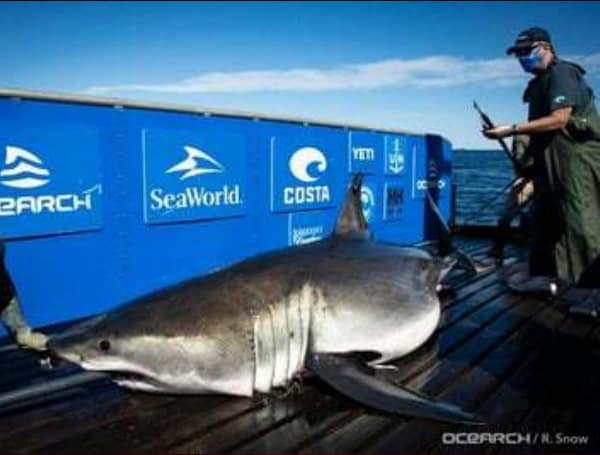Florida is renowned for its diverse marine ecosystem, attracting both nature enthusiasts and thrill-seekers alike. One of the most captivating aspects of Florida’s underwater world is its population of sharks.
To kick off the new year, a 13 foot 3 inch White Shark named Breton pinged off of Florida’s East Coast, spending the first week of 2024 in the Sunshine State waters.
“White Shark Breton spent his first week of 2024 in Florida waters,” said OCEARCH. “We met mature white shark Breton in September 2021 in Nova Scotian waters when he was 13 ft 3in long and weighed an estimated 1,437 lbs.”
With a variety of species inhabiting its waters, Florida offers a unique opportunity to witness these magnificent creatures up close.
Besides the White Shark, here are some other magnificent sharks you can find in the waters of Florida.
1. Tiger Shark: The Majestic Ocean Predator
The Tiger Shark (Galeocerdo cuvier) is a true titan of the sea, reaching lengths of up to 18 feet and weighing over 3,000 pounds. Known for their distinctive stripes and robust bodies, Tiger Sharks are a sight to behold. These apex predators can be found in both shallow reefs and offshore waters, making them a common sight for divers and snorkelers exploring Florida’s vibrant underwater landscapes.
Tiger Sharks are deliberate swimmers, capable of sudden bursts of speed. While they generally approach divers cautiously, they can also display bold behavior. Tiger Sharks have a diverse diet, feasting on an array of prey including fish, birds, squid, whales, dolphins, and sea turtles.
Read: Exploring The Diverse Wildlife Of Florida
2. Great Hammerhead Shark: A Rare Encounter
The Great Hammerhead Shark (Sphyrna mokarran) is the largest species within the Hammerhead family, growing up to an impressive 20 feet in length. While sightings of these magnificent creatures are rare, South Florida offers a chance to witness these giants in action. Great Hammerheads primarily prey upon other sharks, stingrays, and fish, showcasing their prowess as skilled hunters.
3. Bull Shark: The Aggressive Predator
Considered one of the most aggressive shark species in Florida, the Bull Shark (Carcharhinus leucas) has gained a notorious reputation as one of the world’s most dangerous sharks. These formidable creatures thrive in both offshore and inshore waters, including freshwater environments. Bull Sharks are known for their robust bodies and pack mentality, making encounters with them particularly intense.
With lengths ranging from 5 to 14 feet and weighing over 1,500 pounds, Bull Sharks demand respect from divers and swimmers. While they may exhibit wariness towards humans, the presence of food can trigger their aggressive nature. It is important to exercise caution when encountering Bull Sharks in their natural habitat.
4. Scalloped Hammerhead: Grace and Precision
The Scalloped Hammerhead Shark (Sphyrna lewini) is the second largest species within the Hammerhead family, averaging between 6 and 10 feet in length. South Florida is one of the few places where these sharks can be consistently observed. Scalloped Hammerheads are renowned for their agility and sharp turns, making them formidable hunters.
Feeding primarily on fish, stingrays, and smaller sharks, Scalloped Hammerheads play a crucial role in maintaining the balance of Florida’s marine ecosystem. Their presence adds to the allure of diving and snorkeling adventures in the region.
5. Lemon Shark: Abundance in Shallow Waters
Lemon Sharks (Negaprion brevirostris) are among the most abundant large sharks in Florida’s coastal waters. Preferring the shallow inshore areas, Lemon Sharks are often spotted in shallow flats and reefs. With an average length of 4 to 7 feet and weighing up to 500 pounds, they possess a docile nature but can exhibit bursts of speed and aggression.
These mesmerizing creatures are a common sight on the edges of the Gulf Stream, adding an element of excitement to underwater encounters. Observing Lemon Sharks in their natural habitat provides a unique opportunity to appreciate their beauty and grace.
Read: Florida Offers A Blueprint For The Ultimate Saltwater Fishing Destination
6. Sandbar Shark: Speed and Power
Sandbar Sharks (Carcharhinus plumbeus) are frequently encountered in Florida’s coastal waters. These large inshore sharks also venture into deeper offshore waters. Known for their speed and power, Sandbar Sharks are built for fast swimming, aided by their large dorsal and pectoral fins.
Feeding primarily on fish, squid, and crustaceans, Sandbar Sharks contribute to the rich biodiversity of Florida’s marine environment. Their presence is a testament to the delicate balance of nature in these waters.
7. Reef Shark: Fast Predators of the Coral Reefs
Reef Sharks are swift predators that inhabit both shallow and deep reefs. Found in tropical oceans worldwide, they are a common sight in South Florida, the Bahamas, and the Caribbean. Reef Sharks primarily prey upon fish and often hunt in packs, displaying their highly coordinated hunting techniques.
While Reef Sharks typically give divers ample space, they can become aggressive if bait or speared fish are present. These sharks average between 4 and 8 feet in length and can weigh up to 600 pounds, making them a captivating species to encounter in Florida’s underwater paradise.
8. Black Tip Shark: Energetic Inshore Hunters
Black Tip Sharks (Carcharhinus limbatus) are agile predators that frequent Florida’s shallow reefs and flats. With their remarkable speed and jumping abilities, Black Tips are a thrilling sight when in pursuit of prey. Their diet consists of various prey, including smaller sharks and fish.
These sharks average between 4 and 7 feet in length and can weigh up to 350 pounds. Observing Black Tip Sharks in action showcases their remarkable hunting skills and adds a touch of excitement to any oceanic adventure.
9. Mako Shark: Fearless and Ferocious
Mako Sharks (Isurus oxyrinchus) rank among the most aggressive shark species. They primarily inhabit offshore waters, venturing far from the shore. Makos are known for their remarkable bursts of speed, capable of reaching sustained speeds of over 40 mph. These apex predators prey upon various marine creatures, including tuna, swordfish, sharks, and dolphins.
In the deep waters of the Gulf Stream, encounters with Mako Sharks offer a glimpse into the raw power and tenacity of these incredible creatures. With lengths exceeding 12 feet and weighing over 1,200 pounds, Makos leave a lasting impression on those fortunate enough to witness them in their natural habitat.
10. Dusky Shark: A Migratory Marvel
Dusky Sharks (Carcharhinus obscurus) are large requiem sharks that traverse both deep offshore and shallow inshore waters. Highly migratory, Dusky Sharks cover vast distances during their lifetimes. In Florida, they can often be spotted on inshore reefs and in the deep Gulf Stream waters.
With a diet primarily consisting of fish and smaller sharks, Dusky Sharks play an essential role in maintaining the ecological balance of Florida’s marine ecosystem. These sharks average between 5 and 12 feet in length and can weigh close to 1,000 pounds, making them an impressive sight to behold.
11. Silky Shark: The Fearless Offshore Hunter
Silky Sharks (Carcharhinus falciformis) are true offshore sharks, rarely venturing into waters shallower than 100 feet. Known for their fearlessness and constant hunting behavior, Silky Sharks are sleek and built for speed, enabling them to cover long distances in the vast oceans.
Silkys are a favorite amongst divers and marine enthusiasts due to their captivating displays. These sharks are expert hunters, always on the lookout for their next meal. Encounters with Silky Sharks offer a thrilling experience and a chance to witness their remarkable agility and power.
Android Users, Click To Download The Free Press App And Never Miss A Story. Follow Us On Facebook and Twitter. Sign up for our free newsletter.
We can’t do this without your help. Visit our GiveSendGo page and donate any dollar amount; every penny helps.



